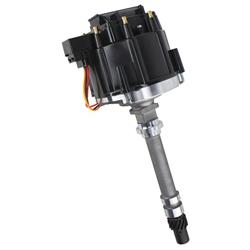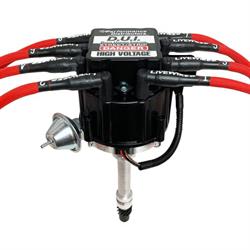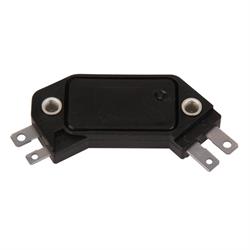What Is an HEI Distributor? Setup, Tuning Tips, and Pros & Cons
The HEI distributor, developed by General Motors in the mid-1970s, was an ignition system ahead of its time. The compact, virtually maintenance-free, all-in-one design revolutionized the ignition over the traditional points and condenser distributors that were standard equipment in the auto industry at that time.
What does HEI distributor mean?
HEI stands for High Energy Ignition, an electronic ignition system that produces higher voltage output and extends spark plug life. The internal coil and ignition module work on a 12-volt system rather than reduced voltage via a ballast resistor. Ballast resistors were required to prevent the points from burning out and potential damage to the coil. The HEI ignition module replaced the need for points and the periodic maintenance required with them to keep the distributor in running condition. The ignition coil was integrated into the distributor cap, eliminating the external coil which had to be mounted on the intake, firewall or fender well.
Does an HEI distributor need a coil?
No external coil is needed—it's built into the cap. Larger distributor caps were utilized to not only house the ignition coil but increase spacing between terminals, which prevented crossfire.
When did GM start using HEI distributors?
This technology was introduced in the mid-1970s, and more than 50 years later, the HEI distributor is still regarded as one of the best ignition systems ever made.
How to Wire an HEI Distributor
Wiring an HEI distributor was simplified with a single 12-volt power supply controlled by the key switch connected directly to the positive terminal of the coil in the cap. No other external wiring is required other than a tach connection.
How to wire an HEI distributor during a conversion from points
The hot wire has to be upgraded, and the ballast resistor removed so that the HEI receives 12 volts. When our customers install a DUI Distributor, we strongly suggest installing a new hot wire that's at least 12 gauge in size so that the distributor gets the proper amount of voltage and amperage for flawless performance.
Pros and Cons of the HEI Distributor
When it comes to upgrading your points style ignition to an HEI distributor, the pros far outweigh the cons:
HEI Distributor Conversion Pros:
- All-in-one design
- Higher voltage output
- No ballast resistor required
- Virtually maintenance-free
- Power and efficiency with larger plug gaps that enhance combustion
HEI Distributor Conversion Cons:
The only possible con could be the larger diameter cap. Limited firewall clearance and engines with blowers or multiple carburetor setups may not have the space for the HEI to fit.
How to Test an HEI Distributor
As with any ignition system, issues with an HEI can arise, such as a no spark condition. The problem could be simple, such as a bad ground, or more complex, with a failed electronic part.
HEI distributor testing procedure:
- First, check for a solid 12-volt power supply and a clean engine ground. Ensure all these connections are tight.
- If those check out, move on to electronic diagnostics which can be done using a multimeter.
- There are two checks on the ignition coil, primary and secondary resistance. Test the resistance values based on the parameters set forth by the coil manufacturer.
- If the coil values are good, test the magnetic pickup coil by disconnecting the two wires from the module and checking resistance.
- If the resistance falls within the specified range, the remaining part will be the ignition module.
How to Install an HEI Distributor
Wondering how to install an HEI distributor on a Chevy 350 or similar old-school V8 engine? It’s a common upgrade for builders moving away from points-style ignition systems, and the process is refreshingly straightforward thanks to the HEI’s simplified, single-wire design.
How to install an HEI distributor:
- Drop the distributor into place, aligning the rotor to cylinder one on top dead center
- Ensure proper gear mesh and oil pump engagement
- Hook up the 12-volt ignition wire and tach wire
- Set base timing with a timing light and lock it down
How to set timing on vacuum advance distributor systems is similar: use a timing light and adjust with the vacuum line temporarily disconnected.
What Is Vacuum Advance on a Distributor?
What does vacuum advance do on a distributor? It adjusts ignition timing based on engine load for better fuel economy and drivability.
How does vacuum advance work on a distributor? A diaphragm inside the advance unit reacts to intake vacuum, advancing timing when cruising or under light throttle.
Does HEI distributor need vacuum advance? Many street applications benefit from it.
How to adjust vacuum advance on HEI distributor: Use an Allen wrench inserted into the vacuum canister port to fine-tune the timing curve for your specific setup.
Performance Distributors' Take: The DUI Upgrade
As mentioned previously, the HEI distributor is superior to many other ignition systems, particularly points-based setups. At Performance Distributors, we’ve improved on this already exceptional design by upgrading key components and branding our version as the DUI (Davis Unified Ignition).
Key upgrades include:
- Higher voltage coil
- Extended dwell in the module for more intense spark
- Support for larger plug gaps
- Hand-built units with polished components and performance advance curves
- Applications for non-GM engines like Ford, AMC, Chrysler, and Toyota
This expanded compatibility has made the HEI-style DUI one of the most versatile and advanced distributor products on the market.




